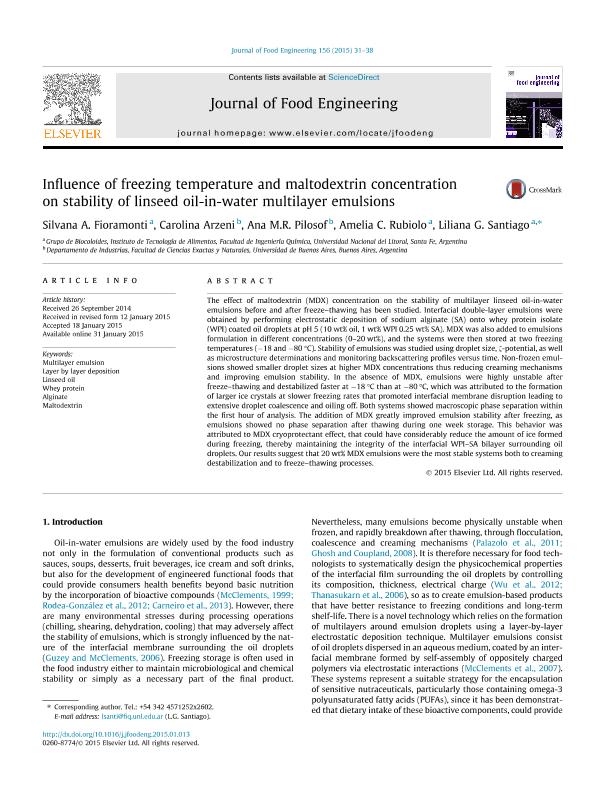Artículo
Influence of freezing temperature and maltodextrin concentration on stability of linseed oil-in-water multilayer emulsions
Fioramonti, Silvana Alejandra ; Arzeni, Carolina
; Arzeni, Carolina ; Pilosof, Ana Maria Renata
; Pilosof, Ana Maria Renata ; Rubiolo, Amelia Catalina
; Rubiolo, Amelia Catalina ; Santiago, Liliana Gabriela
; Santiago, Liliana Gabriela
 ; Arzeni, Carolina
; Arzeni, Carolina ; Pilosof, Ana Maria Renata
; Pilosof, Ana Maria Renata ; Rubiolo, Amelia Catalina
; Rubiolo, Amelia Catalina ; Santiago, Liliana Gabriela
; Santiago, Liliana Gabriela
Fecha de publicación:
01/2015
Editorial:
Elsevier
Revista:
Journal of Food Engineering
ISSN:
0260-8774
Idioma:
Inglés
Tipo de recurso:
Artículo publicado
Clasificación temática:
Resumen
The effect of maltodextrin (MDX) concentration on the stability of multilayer linseed oil-in-water emulsions before and after freeze-thawing has been studied. Interfacial double-layer emulsions were obtained by performing electrostatic deposition of sodium alginate (SA) onto whey protein isolate (WPI) coated oil droplets at pH 5 (10 wt% oil, 1 wt% WPI 0.25 wt% SA). MDX was also added to emulsions formulation in different concentrations (0-20 wt%), and the systems were then stored at two freezing temperatures (-18 and -80 °C). Stability of emulsions was studied using droplet size, ζ-potential, as well as microstructure determinations and monitoring backscattering profiles versus time. Non-frozen emulsions showed smaller droplet sizes at higher MDX concentrations thus reducing creaming mechanisms and improving emulsion stability. In the absence of MDX, emulsions were highly unstable after freeze-thawing and destabilized faster at -18 °C than at -80 °C, which was attributed to the formation of larger ice crystals at slower freezing rates that promoted interfacial membrane disruption leading to extensive droplet coalescence and oiling off. Both systems showed macroscopic phase separation within the first hour of analysis. The addition of MDX greatly improved emulsion stability after freezing, as emulsions showed no phase separation after thawing during one week storage. This behavior was attributed to MDX cryoprotectant effect, that could have considerably reduce the amount of ice formed during freezing, thereby maintaining the integrity of the interfacial WPI-SA bilayer surrounding oil droplets. Our results suggest that 20 wt% MDX emulsions were the most stable systems both to creaming destabilization and to freeze-thawing processes.
Archivos asociados
Licencia
Identificadores
Colecciones
Articulos(CCT - SANTA FE)
Articulos de CTRO.CIENTIFICO TECNOL.CONICET - SANTA FE
Articulos de CTRO.CIENTIFICO TECNOL.CONICET - SANTA FE
Articulos(OCA CIUDAD UNIVERSITARIA)
Articulos de OFICINA DE COORDINACION ADMINISTRATIVA CIUDAD UNIVERSITARIA
Articulos de OFICINA DE COORDINACION ADMINISTRATIVA CIUDAD UNIVERSITARIA
Citación
Fioramonti, Silvana Alejandra; Arzeni, Carolina; Pilosof, Ana Maria Renata; Rubiolo, Amelia Catalina; Santiago, Liliana Gabriela; Influence of freezing temperature and maltodextrin concentration on stability of linseed oil-in-water multilayer emulsions; Elsevier; Journal of Food Engineering; 156; 1-2015; 31-38
Compartir
Altmétricas



